Photo: Collected
Food/Cuisine is considered as one of the most distinctive parts of any culture, and Vietnam is no exception. Keep reading this article, as a typical Tet holiday meal with 10 traditional dishes in this Southeast Asia country, which holds Vietnamese lifelong history values in high regard can immediately blow your mind away!
1. Banh chung, Banh tet
It is safe to say that Tet will never be complete without the appearance of Banh chung, Banh Tet in Vietnamese households’ altars and traditional meals. Legend has it that Banh chung (Savory sticky rice square cake) was created to represent the earth, which plays an important role in Vietnamese culinary culture dated thousand years ago. On the other hand, Banh tet (Savory sticky rice cylinder cake) with the same ingredients and flavor is more prominent in Southern Vietnam.
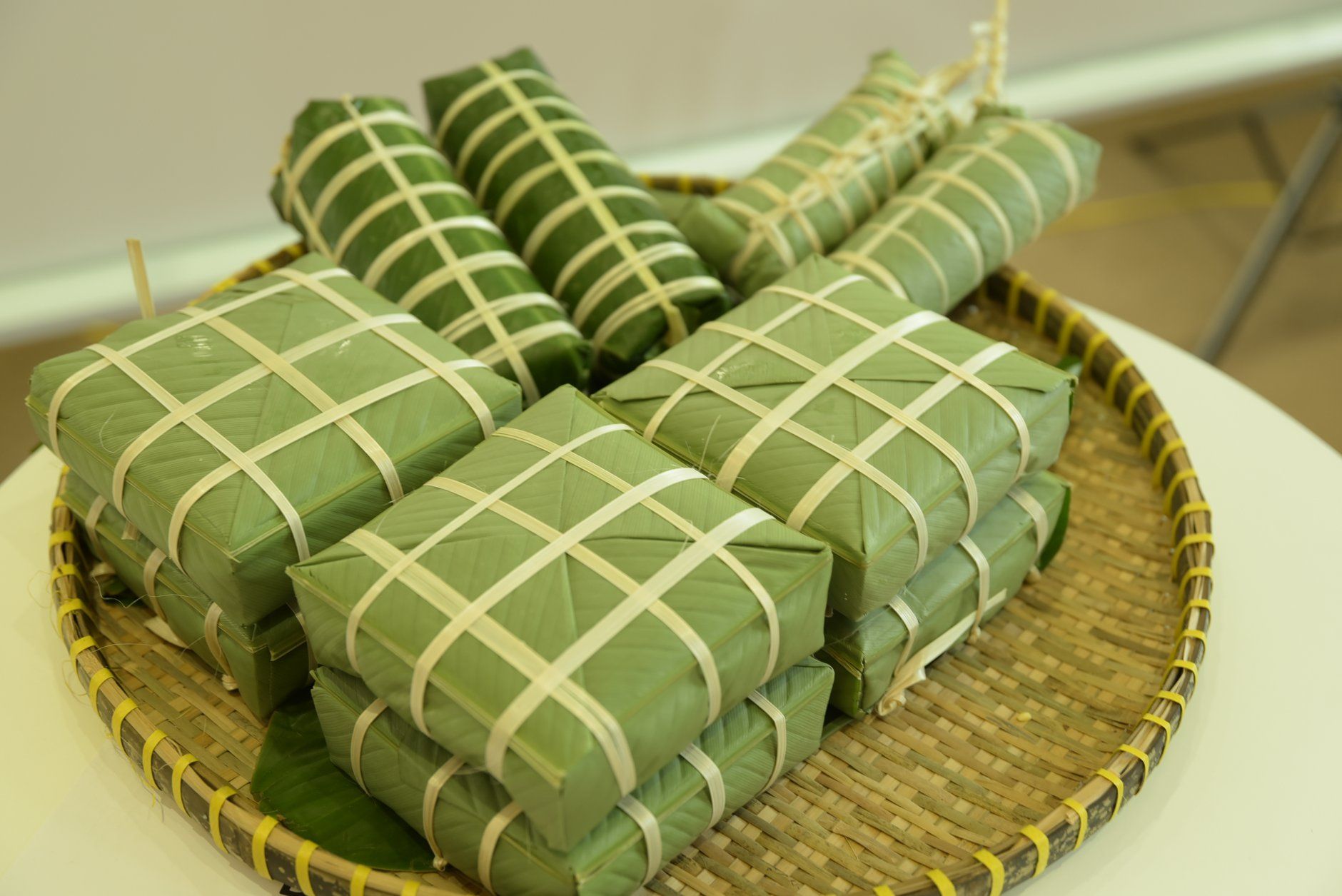
Source: Collected
Banh chung and Banh tet have the main ingredients which are fatty pork, mung beans, and sticky rice. As for Banh chung, Dong leaves are washed thoroughly and placed into a square mold, then families pour in sticky rice covered around the filling of mung beans and meat. Banh tet is packed in a cylinder shape without any molds, therefore people often find it difficult to make them compared to Banh chung. An experienced wrapper makes sure to tight Banh chung and Banh tet by hand and tie them firmly with resilient wooden cubes.
Thankfully, many generations of Vietnamese people have still preserved this distinct traditional beauty by joining the process, happily looking at the flickering firelight under the iconic boiling pot.
2. Thit kho tau (Braised pork and eggs)
If you have a chance to visit the Southern part of Vietnam during the Tet holiday, you are likely to see a bowl of Thit kho tau (Braised pork and eggs) appearing in its families’ meals every time.
In the hope for a year “regular square and round, everything is fine”, pork belly is cut into moderate and square blocks, and duck eggs are round, everything is caramelized in a pot of flavors: the sweetness of sugar, the spiciness of peppers and chilies, the saltiness of fish sauce the bitterness of caramel, and the creaminess of coconut milk. This dish only requires a few ingredients yet brings out a crazy-good flavor, perfect for family gatherings to enjoy when markets and other businesses are still closed.
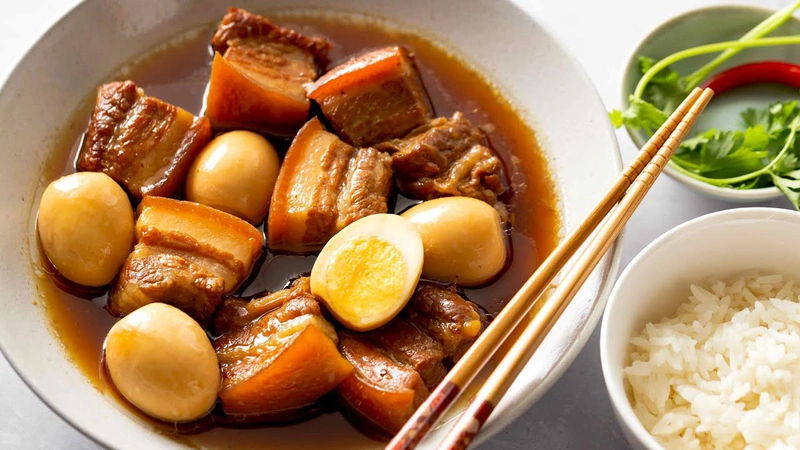
Source: Collected
3. Ga luoc (Boiled chicken)
Based on history, Ga luoc or Boiled chicken is a symbol of fullness and prosperity, this traditional dish is not only an indispensable part of the Tet year-round plates but also features in a lot of Vietnamese families’ anniversaries, parties, or weddings.
Although it sounds incredibly simple, Ga luoc is still a difficulty for many Vietnamese home cooks as you want to control the temperature and the amount of water perfectly so then the meat is not too dry or wrinkled, as well as the inside is cooked and juicy.
When ga luoc is served, it has to be clear-cut by a sharp knife into moderate blocks, without ragged presentation. In many families, chat ga (cutting boiled chicken) is a fun challenge set by the bride's side for a man who wants to marry their daughter.
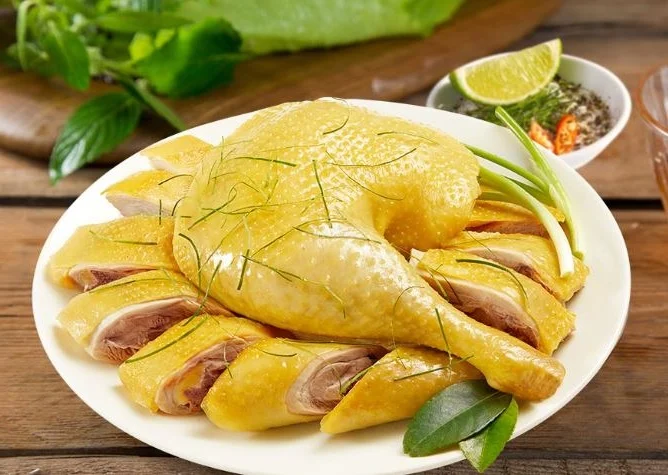
Source: Collected
4. Thit dong (Jellied meat)
We have learned about Thit kho tau in Southern Vietnam, and its respective dish in Northern and Northern Central Vietnam is Thit dong (Jellied meat). Thit dong literally means meat and aspic are set into “jelly” due to the cold weather during the Tet holiday in these regions. In the past, when the living standard was relatively low, Thit dong was considered a treat that could only be eaten on Lunar New Year.
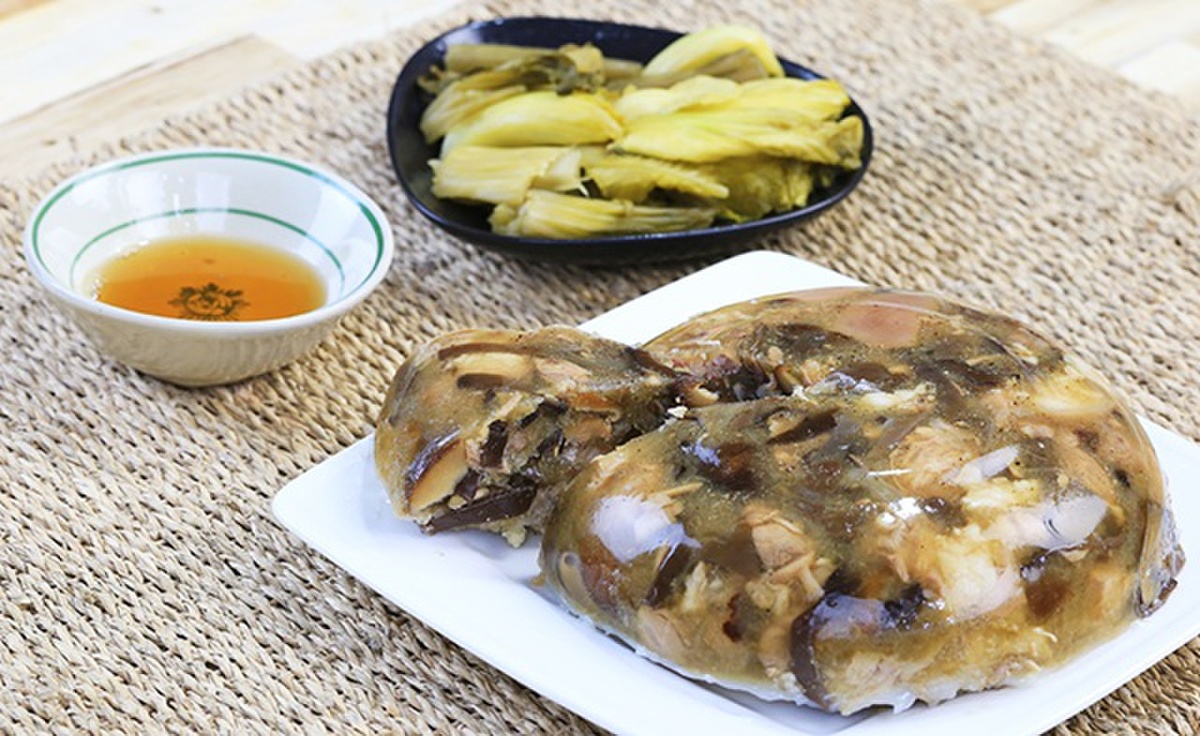
Source: Bep Xua
The primary components of this recipe consist of pork or chicken (specifically ham hock, pork rind or ears, as well as dense skin of chicken), wood-ear mushrooms, and shiitake mushrooms. The presence of collagen in the skin is what enables the aspic to set and maintain its form. The taste of this meal is uncomplicated yet delectable. It pairs perfectly with hot grains, put the aspic on top of a bowl of steaming hot rice until it melts, and you will be tasting an enjoyable mix of consistencies: the smooth broth, tender meat, chewy strips of pork skin, and crispy wood-ear mushrooms.
5. Kho qua nhoi thit (Stuffed bitter melon soup)
For Southerners, Kho qua nhoi thit (Stuffed bitter melon soup) is a must-have dish in family gatherings during the Tet holiday. Kho qua in Vietnamese means sadness and misfortunes (“kho”) will disappear (“qua”). This dish is deemed to bring them an extraordinary sense of peace of mind as if every misery would pass and positive things would come.
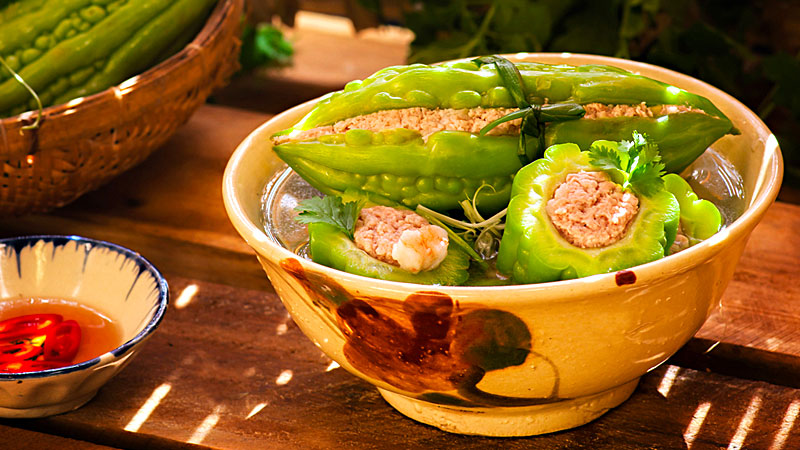
Source: Collected
The recipe is simple and you can easily find ingredients everywhere. First, cut open across a fresh bitter melon and remove the seeds, then stuff it tightly with a combination of minced pork, wooden mushrooms, scallions, and flavorful seasonings including salt, peppers, fish sauce, and a bit of sugar. With a broth, make sure to keep it mild to balance with the marinated meat, slowly add in the stuffed bitter melons, and wait until they are fully cooked. You can enjoy this hearty dish with rice or just by itself!
6. Nem chua (Vietnamese fermented pork roll)
To foreigners traveling to Vietnam, Nem chua is an interesting dish to enjoy with raw garlic and guava leaves, but did you know that Nem chua is also featured in many meals of the Vietnamese year-end occasion?
As people often visit their relatives and friends on those first days of the lunar calendar, there are always some snacks on the coffee table in each family to welcome their guests. Therefore, Nem chua which is not cooking-required and delicious is perfect for this choice.
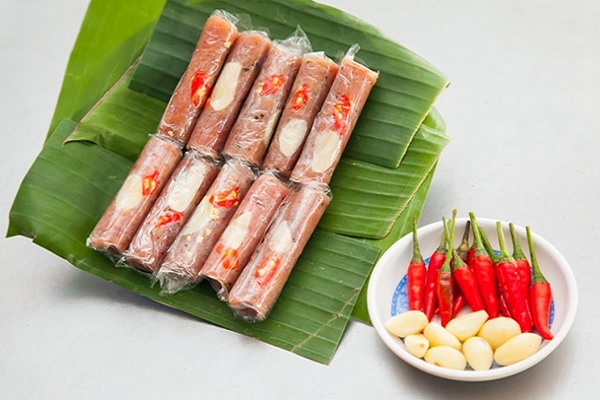
Source: Collected
Nem chua is made by combining fresh pork and a variety of spices, which are then wrapped in banana leaves. True to its name, the pork will be fermented under the leaf covering, resulting in a unique blend of flavors including sweet, tangy, and spicy.
7. Xoi gac (Gac sticky rice)
In Vietnamese culture, the red color is believed to bring luck and wellness, therefore Gac, or spiny bitter cucumber in English, which has a very pigmented red color when it is due, is widely used on the rice tray for ancestral offerings during the beginning of the new year.
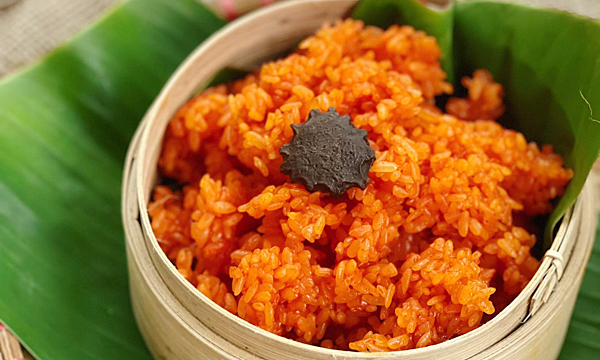
Source: VnExpress
This special type of sticky rice is made from high-quality glutinous rice and combined with spiny bitter cucumber before being steamed. The end result is a visually stunning and enticing bright red color. Consuming chicken and sticky rice with Gac is a desire for a prosperous, harmonious, and fortunate year for Vietnamese households.
8. Cu kieu (Pickled small leeks)
“Fat meat, pickled onions, red parallel sentences.
New Year pole, strings of firecrackers, green banh Chung”
Every Vietnamese people think about this "six-eight" verse form in their hearts when the Lunar New Year rolls around. Vietnamese cuisine values harmony and balance in flavor, so coming with the richness and greasiness of fatty meat, jellied meat, banh chung, etc is always pickled small leeks. Moreover, these fermented vegetables also help to promote food digestion.
The small leeks are pickled in a flavorful sauce for about 2 weeks and are often accompanied by Tom kho (dehydrated shrimp). This side dish provides a crispy texture and a blend of sweet and tangy flavors, making it a perfect accompaniment to other dishes.
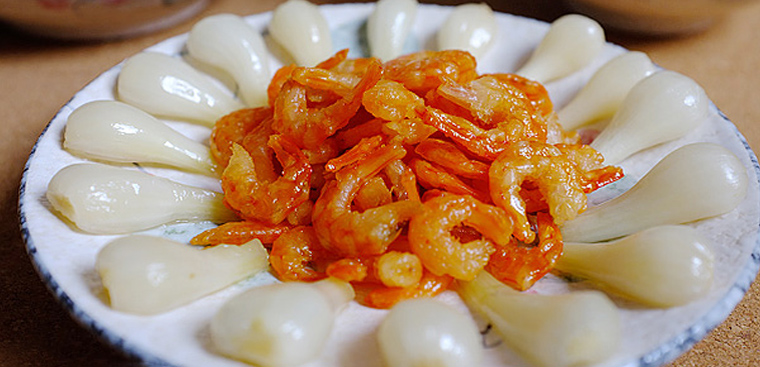
Source: Collected
9. Mut and cac loai hat (Candied fruits, seeds, and nuts)
Adults in Vietnam often jokingly say that Tet is an excuse for children to indulge themselves with sweets as every house puts out a charming box full of candied fruits and nuts to serve their guests.
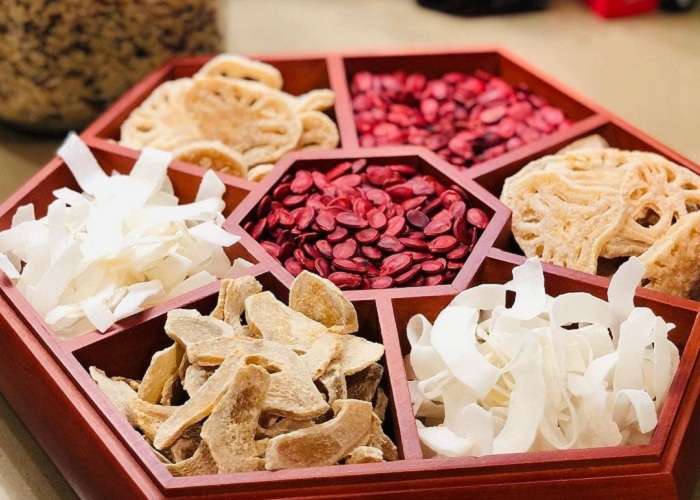
Source: Collected
Foreigners are probably familiar with some kinds of popular fruits to make Mut such as coconuts, gingers, squashes, tamarinds, turmerics, and carrots. The natural sweetness from fruits and floury dried sugar will make you keep eating! As for seeds and nuts such as roasted watermelons, sunflower seeds, cashews, and many others, what’s better to pair with than a wholesome conversation and a cup of tea? Moreover, these treats also benefit your health as a source of protein and organic acids, vitamins and minerals, etc.
10. Mam ngu qua (Five-fruit tray)
During the Vietnamese New Year, it is traditional to have a five-fruit tray on the ancestral altar. Some believe that the five fruits represent ngũ hành (the five elements of nature) - metal, wood, water, fire, and earth. Others view the tray as a representation of the fruits of a family's labor throughout the previous year, which are offered to heaven, earth, and ancestors as a gesture of respect and thankfulness.
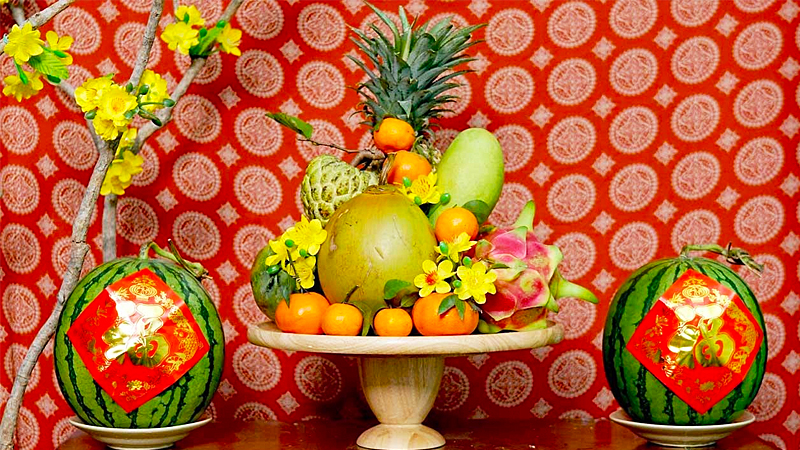
Source: Collected
In the Southern region of Vietnam, the tradition of assembling a five-fruit tray is based on “cầu sung vừa đủ xài” (wish for enough prosperity). The pronunciation is interestingly matched with the sounds of five fruits: soursop, fig, coconut, papaya, and mango.